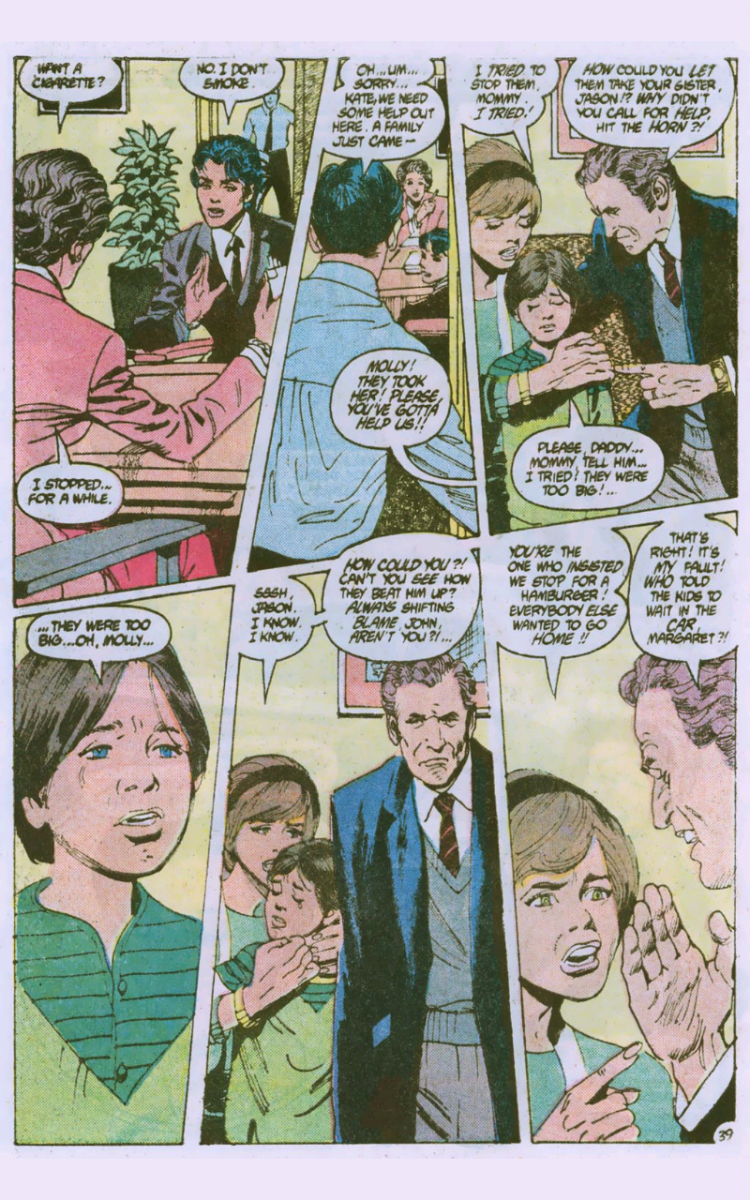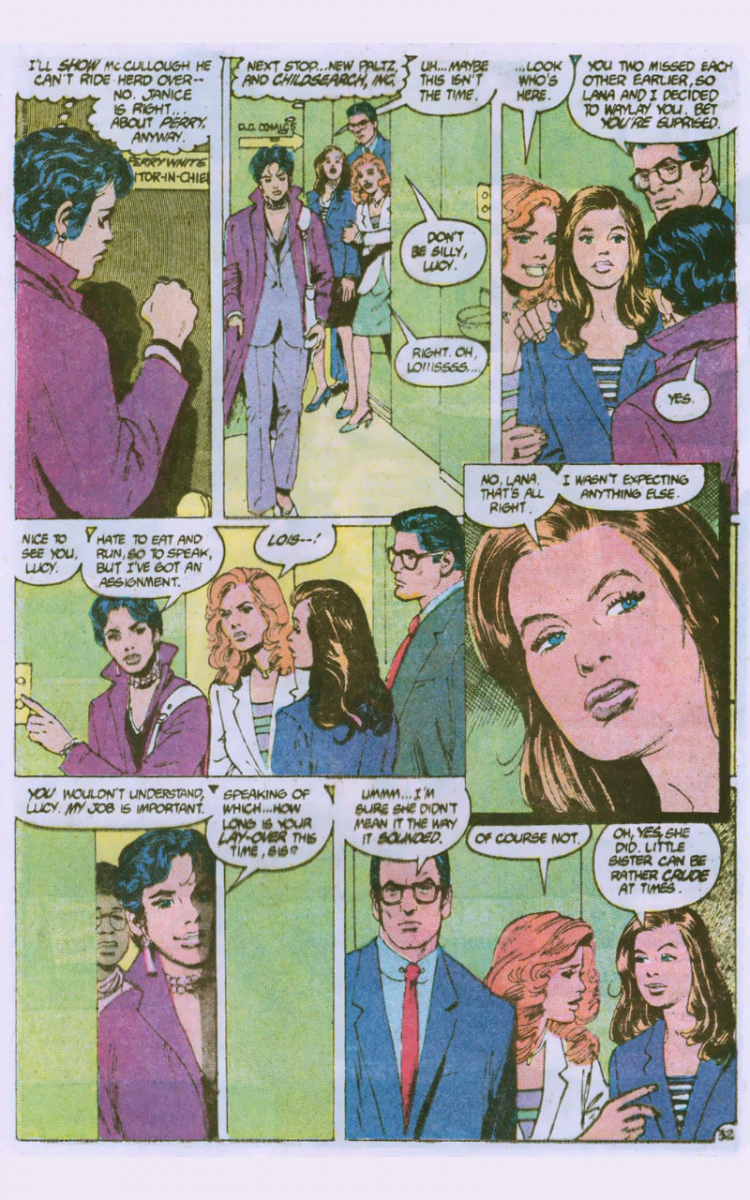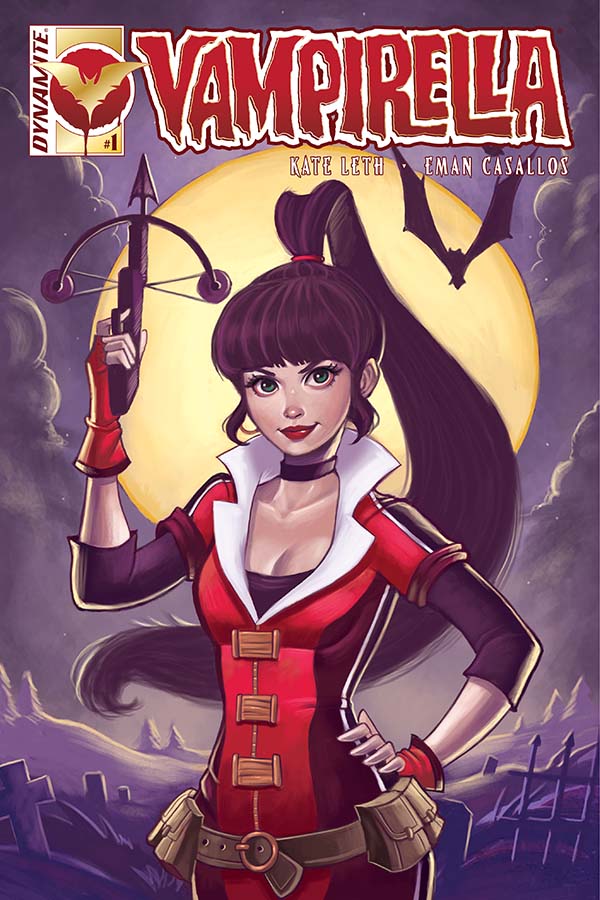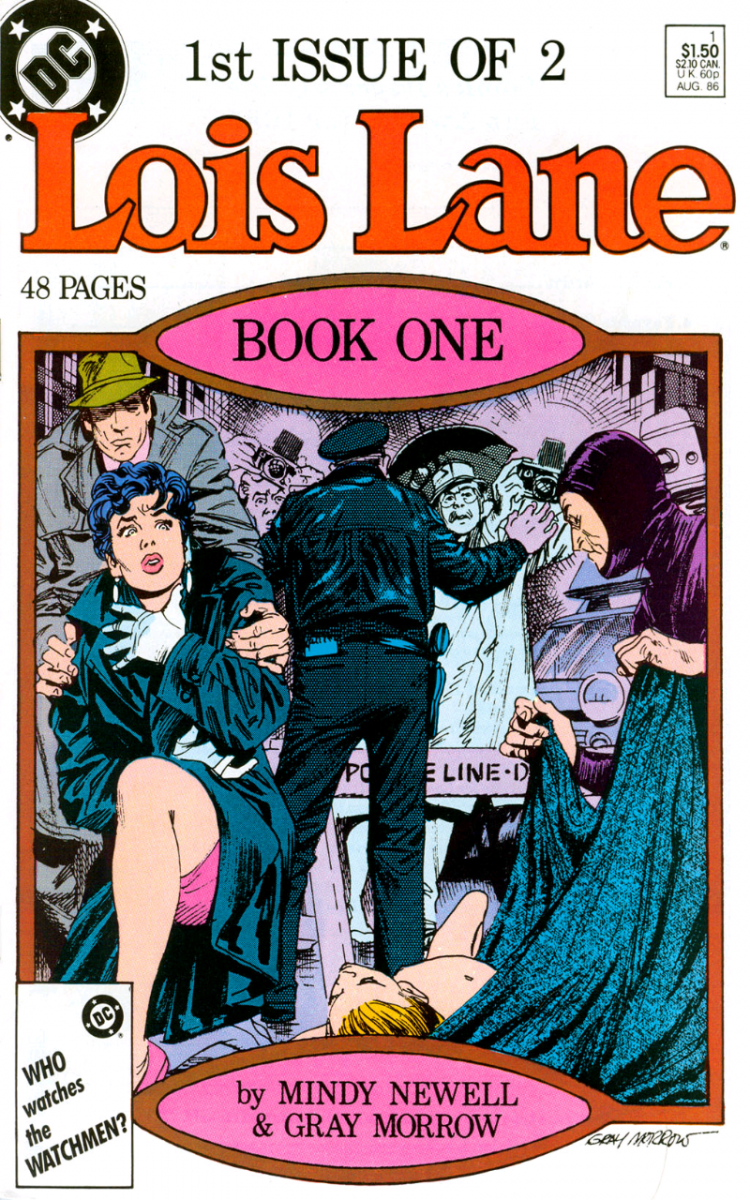Open Mike Night: Vampirella (2016) #1 & Lois Lane (1986) #1-2
FTC Statement: Reviewers are frequently provided by the publisher/production company with a copy of the material being reviewed.The opinions published are solely those of the respective reviewers and may not reflect the opinions of CriticalBlast.com or its management.
As an Amazon Associate, we earn from qualifying purchases. (This is a legal requirement, as apparently some sites advertise for Amazon for free. Yes, that's sarcasm.)

Written by: Kate Leth
Art by: Eman Casallos
Colored by: Valentino Pinto
Lettered by: Erica Schultz
Published by: Dynamite
Cover Price: $3.99
Mike Maillaro: The biggest reason I became a Vampirella fan was because of Nancy Collins terrific work on the character the last few years. I hadn’t really read any Vampirella over the years, but I got her first volume as a review copy and immediately loved it. She helped expand the lore, showing off the different types of vampire in Vampirella’s world, and spending a lot of time looking at how Vampirella fit in this world. When we last saw Vampirella, she had decided to turn her back on being the Queen of the Nosferatu.
This issue starts with Vampirella renting a haunted house in Los Angeles with her valet and her werewolf boyfriend. Vampi immediately finds out that in Los Angeles everyone has a camera, and she quickly finds herself “unique” clothing landing her on the front of tabloids, which is an issue since she prefers to lay low when she works. She changes to a more suitable costume, and soon finds herself squaring off against a demonic creature called Slade who seems to like to feed on extras.
It was really hard for me to review this issue without thinking about everything that was missing here from the last volume. Monster hunters, conspiracies, the different types of vampires, etc. This seemed like a real back to basics approach for Vampirella. That is not inherently a bad thing, but it did strip away a lot of what I liked about the book.
I also thought it was a little odd that they made such a big deal about Vampirella changing her outfit. Many times in the last series, she had worn full body clothing. The bathing suit look helps sell covers, but it’s not really all that representative of a modern Vampirella anyway.
Mike Weaver: The bathing suit is her iconic look, like it or not. When you ask people what Vampirella looks like (assuming they know who she is), it’s that red bathing suit with a detached collar that they’ll think of. If you’re starting a new volume, you need to at least throw that in there.
I disagree with thinking that this issue stripped everything away...it’s only one issue, and doesn’t contain any real wasted space. Perhaps all those ideas will run into it later. There’s also the side story of a particular extra that Slade is intending to feed on that runs through this, giving us an image of what’s going on in the bad guy’s camp, plus various people stalking Vampirella for social media reasons. I think it would have hurt the story to shove more mythos into it.
Maillaro: I actually don’t have a particularly huge issue if they new creative team decided to move in a whole different direction. To be fair, that is exactly what Nancy Collins did herself. The only reason I even commented on that is because I really did like the last volume, so at first I really did feel some disappointment when I started this issue and realized that so much of what I had liked seemed to be place on the wayside. Though like you said, that could just be temporary. I am not going to let that destroy my enjoyment of the new series.
I still think there was plenty to enjoy about this new Vampirella series. I especially loved her relationship with her former valet, Coleridge. I don’t know why, but the idea that Vampirella has her own personal assistant just makes perfect sense to me.
Weaver: She almost has to have her own personal assistant, with the way she operates. I liked Coleridge a lot in this as well.
I do have to wonder, though, if Vampirella is a character whose time has more or less passed. She was edgier and more adult in a time that most comics were still held down by the comics code, but now the rest of the industry has caught up to her. Is this comic just hoping to cling to the former glory, or is there a reason to believe that it can be financially successful? I’m not saying Vampirella was ever bad per se, but it definitely benefitted from filling a niche that’s now filled with other stuff.
Maillaro: It’s a real good question. I honestly don’t know how well Vampirella has sold, historically or recently. I know Dynamite seems to have a lot of faith in the character, since they have been pushing her in several crossover stories lately. Legenderry. Sword of Sorrows. Vampirella/Aliens.
I do think that with all the talk about diversity in comics, Vampirella is a good character to serve as a flagbearer for a company like Dynamite, especially when you put a female creative team on the book. She’s got a lot of history, you can go a wide variety of direction on the character, and at the end of the day, she’s just a fun character to read and write. And I would love if they used her to bring back a little more horror in comics. I miss horror comics. I was so happy when Crossgen did Route 666, and there have been a few other good ones recently, but it’s still basically a dead genre.
Weaver: I find that just about any non-superhero genre is a hard sell these days. There’s been a few efforts at war comics and western comics...honestly, of any off-genre, horror probably has the most representation, at least it did before Hellblazer became a movie and a TV series. I haven’t checked in on comics Constantine in a while, so I’m curious if they’ve sanitized him a little due to that.
She’s a recognizable character, and beyond the history, it’s a name everyone recognizes. If she can sell a comic, I’m happy for it...but I’m not sure she can, especially since her earlier incarnations are more known for cheesecake than plot.
I’d give this a solid 4 for writing, and a 4.5 for art. The character designs were really good, and the action flowed decently.
Maillaro: I thought it was a fun comic, but I am not sure there was a lot of meat to it. I think I would probably go slightly lower for the story, 3.5. But I will stick with your 4.5 for the art. I do think Kate Leth is a good choice to write this book, and I will definitely stick around to see where she is going to take Vampirella.
Writer: Mindy Newell
Artist: Gray Morrow
Colored: Joe Orlando
Lettered: Agustin Mas
Published by DC
Cover Price: $1.50
Weaver: This story came out at a time that both Marvel and DC were doing self-contained edgier books about social problems, the most famous being the X-Men’s God Loves, Man Kills. In it, Lois Lane finds a lead about a dead baby that she believes will resurrect her career after an embarrassing gaffe on her last assignment and becomes completely obsessed with everything involving missing children. She starts to get so wrapped up in it that she ignores every member of her supporting cast, including her sister who just randomly stopped by after not seeing her for a long time.
What’s really interesting about this to me, as an issue comic, is that Lois, with all her reporting power and all of her focus set on this, doesn’t in the end make any kind of difference whatsoever. The story remains buried off the lead page, and none of the cases that she looks into improve at all. It’s pretty realistic, which is tough to handle at times, since we turn to comics for a certain amount of escapism.
Maillaro: I thought this was a real powerful and meaningful story. In the middle of both issues, there were extensive text pieces talking about the real world ramifications of kidnapping, including how and why children can get taken, and what can be done about it. It the late 70’s and 80’s, Marvel and DC seemed to try and do a little more “social justice” in their comics, and this comic is a definitely product of the times.
One thing that did bother me is that at times, the writing did feel a little hamfisted. Even the next issue box was a little overwritten, “Some surprising revelations for Lois while she finds that the phenomenon of missing children is widespread, regardless of race, color, creed or socioeconomic background.” Like Weaver said, in the end, there didn’t seem to be anything anyone could do to solve these problems. Clark Kent shows up a few times, but never as Superman. I kept waiting for him to at least try and save someone, but in the end, most of the characters seem more concerned about Lois’s descent into obsession than making any real efforts to fix the problem. It’s realistic, but when you are reading a comic story, you kind of hope for a little more uplifting ending.
Weaver: The only times they even mention Superman is when people bring Lois’ love life into the discussion. While I can get behind not tossing the full power of the Man of Steel towards any of the situations, I wanted Lois or Inspector Henderson to solve something. Anything. But, in the end, all that happens is that you find out Lana Lang had a baby that no one knew about who was abducted and killed...and Lois can’t really do anything for her either.
 It’s realistic that it’s a downer story, I get that. And it’s interesting to note that it’s written by a nurse who did a try-out book for DC way back in the day, also one of the few women to write Lois in her history of solo stories. I’d imagine being a health professional gives you a really stark look at these social issues.
It’s realistic that it’s a downer story, I get that. And it’s interesting to note that it’s written by a nurse who did a try-out book for DC way back in the day, also one of the few women to write Lois in her history of solo stories. I’d imagine being a health professional gives you a really stark look at these social issues.
Yeah, things were pretty hamfisted, but at the same time, it was pretty sad that now, thirty years later, the exact things that are discussed in this comic are still happening. And in similar numbers. Which brings the side question of...could a “social issue” comic really do anything, especially considering that at the time adult readership in comics wasn’t that high?
Maillaro: Unfortunately, I am not sure comics as a media can ever really have that huge an impact on real social issues. I can’t help but think of the Spider-Man comic where we find out that he was molested as a child by an older student. Again, it was an important issue, but done in such a way, I could not possibly imagine that it had any real impact. MAYBE, it might make a few children speak out about things that happened to them. I hate to be that jaded, but I can’t help but think of that whenever I read a comic like this.
On a weird aside, they once did a trade containing a lot of those Spider-Man PSA comics..and in the most bizarre decision ever, they included a free “Aim toothpaste” comic I had back in the day. Odd to go from molestation and drug abuse to a comic that was trying to sell toothpaste. Whoever packaged that collection was either insane or a marketing genius. Probably both. Especially since most of those comics were free when they came out...and the trade was a ridiculous $35...
Weaver: Toothpaste is a social issue. I guess.
 Maillaro: I thought it was a powerful story, and Lois’s reactions made a lot of sense. At times it was a little heavy-handed, but I think that might be necessary for this kind of story. Too light a touch and it would almost feel like you were trying to make light of the issue. The writer here seemed determined to try and help solve the problem, including extensive information in the text pieces. I feel like I should rate this book higher, but at the end of the day, I would have to settle on a 4 for the writing, 4 for the art.
Maillaro: I thought it was a powerful story, and Lois’s reactions made a lot of sense. At times it was a little heavy-handed, but I think that might be necessary for this kind of story. Too light a touch and it would almost feel like you were trying to make light of the issue. The writer here seemed determined to try and help solve the problem, including extensive information in the text pieces. I feel like I should rate this book higher, but at the end of the day, I would have to settle on a 4 for the writing, 4 for the art.
Weaver: Very often, a comic like this can end up being laughable in retrospect. For instance, the old Harry Osborne drug abuse issues are hilarious in some ways. However, in this case, it still feels serious. That’s pretty impressive.
I’ll go 4.5 on the writing and 3.5 on the art. Sometimes Lois’ clothing was really strange, and I couldn’t get past it.
Maillaro: Not to mention the old “My sidekick is a junkie!” story in Green Arrow/Green Lantern (which I think we reviewed a while back). Though I did think that story was better just because of Ollie’s reactions. It felt real. Depressing, but real.
Maillaro: The team who did the last Daredevil series (Waid and Samnee) are taking over Black Widow this week, so I think that would be a great one to review. Double dose of Natasha?
Weaver: Sounds great to me. What kind of old Black Widow comic are you thinking?
Maillaro: Let’s do her first appearance. She’s just a different character from that, it should make a great parallel.
Weaver: Oh man, that old Black Widow outfit. Okay, sounds good to me.
Final Scores
|
Maillaro – Story (out of 5) |
Weaver – Story (out of 5) |
Maillaro – Art (out of 5) |
Weaver – Art (out of 5) |
|
|
Vampirella (2016) #1 |
3.5 |
4 |
4.5 |
4.5 |
|
Lois Lane (1986) #1-2 |
4 |
4.5 |
4 |
3.5 |




